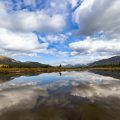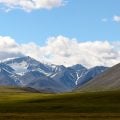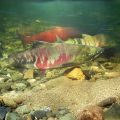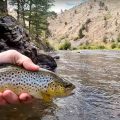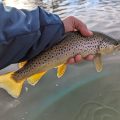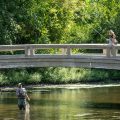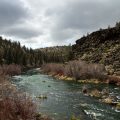Science
New Fish Handling Best Practices
As part of their annual No Fish Dry July initiative, the folks over at Keep Fish Wet (KFW) have released new best practices for handling trout. Of particular note is new research that says the long-held belief that trout fishing should stop at 68 Fahrenheit is incorrect. New research from Jamie Madden, a who has her Master's from Carleton University, worked...
AFF Launches Salmonfly Project on Yellowstone River
The AFFTA Fisheries Fund (AFF) - the conservation arm of the American Fly Fishing Trade Association - recently announced the launch of The Salmonfly Project on the Yellowstone River. The Salmonfly Project is a research initiative that studies the decline of aquatic insects in Western rivers. According to their website, the Salmonfly Project was started by...
Alaska's Orange Rivers
Not long ago, MidCurrent reported on the phenomenon of some Alaskan rivers turning orange. That news has since hit other outlets, renewing interest in this phenomenon, and what it could mean for fly fishing in the Last Frontier. In short, some rivers in Alaska's Brooks Range (a west-east mountain range located above the Arctic Circle) are turning alarming...
Warming Arctic Opens New Salmon Habitat
New research from the University of Alaska Fairbanks shows that recent warm ocean temperatures have spurred higher Pacific salmon abundance in the Canadian Arctic. According to the report, "salmon haven't historically been seen in large numbers in the Arctic Ocean and its watersheds, but in recent years incidental catches by subsistence fishermen have...
Trout Develop Distinct Genes in Mine-Polluted Rivers
A fascinating new study out of the United Kingdom shows that trout living in mine-polluted rivers are genetically different than trout living in clean water. According to an article by the University of Exeter at Phys.org, a recent study conducted at 71 sites in Britain and Ireland shows a distinct genetic difference in brown trout that live in...
Science In The Thorofare
The Thorofare region of Yellowstone needs no introduction in angling circles. It's a legendary place many of us hope to visit one day. If you haven't been there, but are dreaming of doing so, this recent story in Fly Fisherman Magazine may help you clear your calendar and make a trip happen. Paul Weamer wrote about the incredible science going on to track...
Orvis Podcast: Trout Stream Bugs
In this recent episode of the Orvis podcast, Tom Rosenbauer chats with Anna Le about aquatic entomology in trout streams. Le is an educator and aquatic entomologist, and she dishes out some great tips to help you learn to gauge the health of a river just by looking at its bug life. You can find the podcast here.
Fish Getting Smaller as Water Warms
A new study looks at one of the leading theories for an explanation as to why fish are getting smaller as waters warm around the world. The leading theory, according to this article from Phys.org, is that a fish's gills have a harder time extracting oxygen from warmer water, leading to stunted growth. That theory, however, has now been proven mostly false...
PFAS: Forever Chemicals
Late in 2023 MidCurrent ran a story about an upcoming PFAS (polyfluoroalkyl substances) ban set to take place in the coming years. PFAS are used to waterproof everything from rain gear to waders, which makes them an integral part of an angler’s outfit. PFAS shed off our fly fishing gear and enter the environment, contaminating everything from fish...
Washington's Wildlife After Dam Removal
The folks over at Engadget - yes, Engadget - put together a wonderfully enlightening story on the impacts of the Elwha River Dam removal in Washington State. As we've documented extensively here are MidCurrent, the removal of the Elwha River dams has been one of the best success stories for conservation in recent memory. It's the largest dam removal project...

